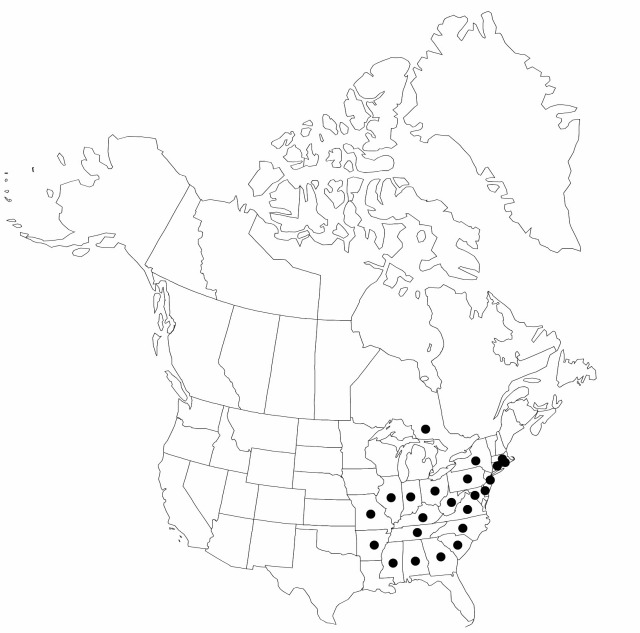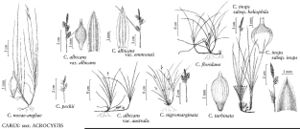Carex nigromarginata
Ann. Lyceum Nat. Hist. New York 1: 68. 1824.
Plants densely cespitose; rhizomes ascending to erect, reddish brown, 0–10 mm, stout. Culms 8–27 cm, scabrous distally; bases (remnants of old leaves) strongly fibrous. Leaf blades green, greatly exceeding culms, 1.4–4 mm wide, herbaceous, papillose to scabrous abaxially, papillose to scabrous adaxially. Inflorescences with both staminate and pistillate spikes; peduncles of staminate spikes 0.3–0.8 mm; proximal cauline bracts leaflike, usually shorter than inflorescences. Spikes: proximal pistillate spikes 2–3 (basal spikes 0); cauline spikes overlapping, proximal 2 separated by less than 7 mm, with 6–15 perigynia; staminate spikes 5.3–10 × 1.1–2.3 mm. Scales: pistillate scales pale to, usually, dark reddish brown to purplish brown, with similarly colored or narrow white margins, ovate to lanceolate, 2.9–3.7 × 1.2–2 mm, equaling or exceeding perigynia, apex acute to acuminate or cuspidate; staminate scales ovate, 3–4.3 × 1–1.8 mm, apex obtuse to acute or acuminate. Anthers 1.4–2.6 mm. Perigynia pale green, veinless, ellipsoid, 2.8–3.6 × 1–1.3 mm, longer than wide; beak straight, pale green, 0.7–1 mm, weakly ciliate-serrulate, apical teeth 0.1–0.4 mm. Stigmas 3. Achenes brown, ellipsoid, obtusely trigonous in cross section, 1.4–2 × 0.9–1.2 mm. 2n = 36.
Phenology: Fruiting early Apr–late Jun.
Habitat: Acidic soils of rocky, dry woods, thickets, and clearings, in partial shade of mixed hardwood-pine forests or full sun along open roadsides and clearing edges, often adjacent to streams
Elevation: 10–800 m
Distribution

Ont., Ala., Ark., Conn., Del., D.C., Ga., Ill., Ind., Ky., Mass., Miss., Mo., N.J., N.Y., N.C., Ohio, Pa., R.I., S.C., Tenn., Va., W.Va.
Discussion
Selected References
None.
